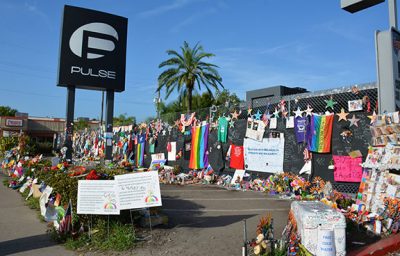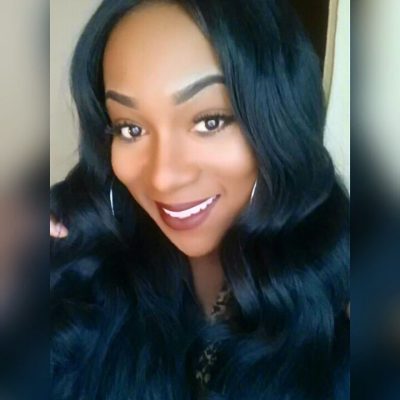Making public history more queer
29 March 2017 – Connie Mandeville
Editor’s Note: This is the second of a series of posts reflecting on Gregory Samantha Rosenthal’s article, “Make Roanoke Queer Again: Community History and Urban Change in a Southern City,” published in the February 2017 issue of The Public Historian, and on how the Roanoke project relates to other LGBTQ public history projects.

A community mourns—a memorial created for the 49 who died at the Pulse Nightclub shooting. Photo credit: Walterpro, licensed under CC BY 2.0.
In their essay, “Make Roanoke Queer Again: Community History and Urban Change in a Southern City,” Rosenthal discusses the challenges, benefits, and importance of preserving Roanoke’s queer history, focusing on their experience as cofounder of the Southwest Virginia LGBTQ+ History Project. Following the example of earlier LGBTQ activists, Rosenthal and other members of Roanoke’s LGBTQ community started a grassroots campaign to preserve their history, collecting archival materials, launching website exhibits, and creating community events such as the LGBTQ history bar crawl. While Rosenthal emphasizes the importance of preserving queer history to fight what he calls the “queer erasure” that resulted from decades of gentrification across the country, there is another vital reason for public historians to actively seek out queer history: because LGBTQ people are dying.
We are all familiar with the recent massacre at the Pulse nightclub in Orlando in June 2016 during a Latinx night at the club. Fewer of us are aware that more trans people were murdered in 2016 than in any previous year. Twenty-three trans people were murdered last year, and that number does not include those who died by suicide. Trans women of color are the most likely to be victims of murder—72 percent of trans murder victims are trans women of color. The average lifespan for trans women of color is only thirty-five. They are also likely to face discrimination and be poor—34 percent of black trans people live in poverty. As public historians, one way to help save these lives is to help collect and tell their stories. This simple act helps raise awareness not only of the violence committed against trans people, but also affirms that the trans community has a rich history that deserves to be told.

Rae’lynn Thomas, just one of the trans women of color murdered in 2016, was shot and killed by her mother’s ex-boyfriend in Columbus, Ohio, in August. Photo credit: Facebook.
As Rosenthal notes, most of queer history focuses on white cisgender gay men, excluding lesbians, bisexuals, trans individuals, and the queer community. However, the Southwest Virginia LGBTQ+ History Project actively collects stories from people who are not white cisgender gay men, setting an example for other public historians to follow. The project’s bar crawl included stories of the trans community in Roanoke’s past, when most were afraid to dress in drag because of threats of being arrested. The tour also included stories of the transvestite sex workers who once occupied the now gentrified streets. While Rosenthal argues that telling these stories helps combats queer erasure, I suggest that making places queer does so much more than that. It helps the LGBTQ community become more visible, more human, and, therefore, not expendable. It sends a message that their lives do matter, a powerful message that should not be undervalued.
But most LGBTQ history projects are initiated by the LGBTQ community themselves. It is time that public historians take initiative and start actively making their sites queer. The term queer does not apply only to sexual orientation and gender identity—anything that is against the norm can be considered queer. Cathy J. Cohen championed this definition of queer in her 1997 essay, “Punks, Bulldaggers, and Welfare Queens: The Radical Potential of Queer Politics?” In the article, Cohen argues for a political coalition of all people who are ostracized for being socially and culturally deviant, essentially punks, bulldaggers, and welfare queens. However, queer tends to refer to those who break away from heteronormative families. This includes unmarried women without children, single women with children, LGBTQ couples with or without children, etc. Expanding the definition of queer in this way emphasizes how heteronormativity does not just affect the LGBTQ community, but all who dare to be different.
We need to follow Cohen’s expanded definition of queer to recognize how numerous systems of oppression are working inside our museums. One way to challenge these heteronormative structures is to examine the relationship between nuclear families and our institutions. Overall museums tend to focus on families in their interpretations and in their events, which marginalizes people who break heteronormative norms yet want to go to museums and feel represented. Hosting events for adults can help make museums queer, but including narratives of people who do not have nuclear families is important as well. Not all museums will have queer stories to tell, but there are many bachelor or spinster inhabitants in house museums and other queer figures throughout history whose stories can be told by museums. Even single mother or father households, which are extremely common yet not represented in museums, can be counted as queer.
As a field, we have worked to make public history more LGBTQ friendly. In 2015 the American Association of State and Local History published Susan Ferentinos’s Interpreting LGBT History at Museums and Historic Sites and in 2016 the American Alliance of Museums published LGBTQ Welcoming Guidelines for Museums. Both are great introductions on integrating LGBTQ history into our sites, but the LGBTQ Welcoming Guidelines for Museums additionally focuses on LGBTQ-friendly hiring and membership practices, such as using gender neutral language in job announcements and in membership mailings.
These are important first steps in making public history more queer. But we, as public historians, can also learn from the queer community and queer theory as we rethink how museums operate. Be odd. Be eccentric. Challenge boundaries. Maybe we don’t need to take it to the streets like the unapologetically queer ACT UP activists during the HIV/AIDS crisis (or maybe we do), but we do need to be advocates for our communities, including the LGBTQ community. In the wake of the Pulse Massacre, trans bathroom laws, and the rising number of reported trans murders, it could be the difference between life and death for the LGBTQ community.
~ Connie Mandeville is a graduate student in history and public history at the University of South Carolina researching LGBTQ Pride movements in the southeastern United States.



